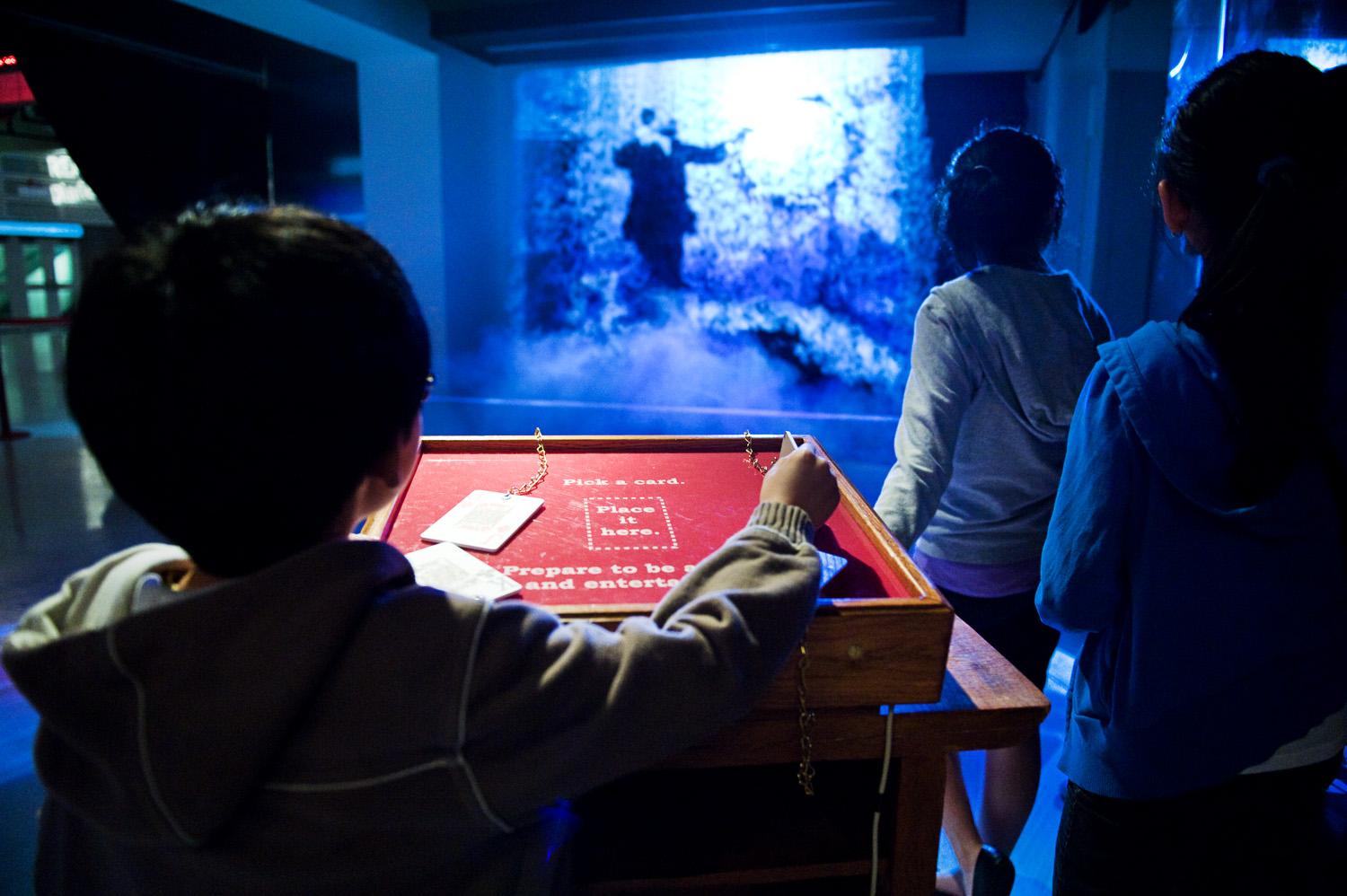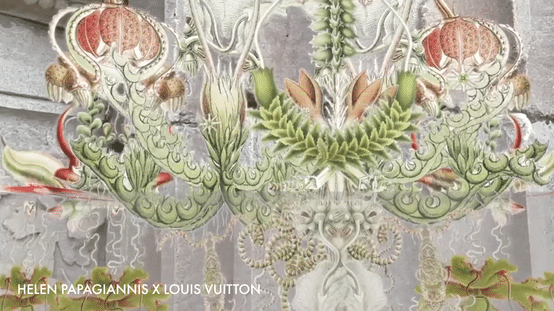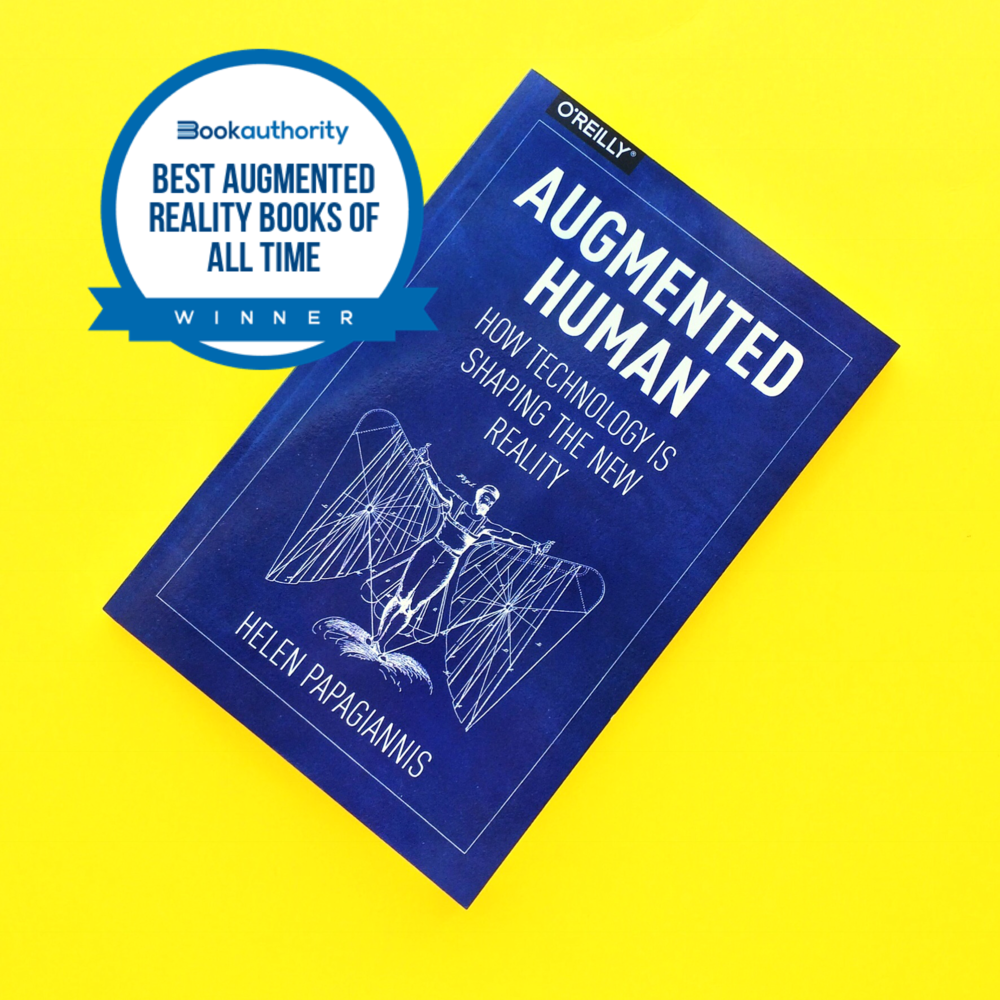Selected Work + Projects
“The Amazing Cinemagician”, exhibition at Ontario Science Centre, Toronto, by Dr. Helen Papagiannis, 2010. Details below. Photo credit: Pippin Lee.
Louis 200, commissioned by Louis Vuitton, 2021
Louis Vuitton invited 200 artists to reimagine the iconic trunk in celebration of their founder’s 200th birthday. Featured artists include Drake, BTS, Es Devlin, Dr. Helen Papagiannis, as well as Lego, and The Simpsons. The artwork celebrates the innovative spirit & legacy of founder Monsieur Louis Vuitton and are on view in all 400 store windows worldwide. The trunks, both physical and digital will be on auction at Sotheby’s. All proceeds from this legacy project to charity.
AR Wonder Kingdom, Commissioned by Adobe, 2021
A a shrine to creativity and new possibilities, Wonder Kingdom is an immersive Augmented Reality artwork viewable on iOS devices. The experience is curated into the Adobe Aero app.
Sea Queen AR NFT curated by Paris Hilton, 2021
My latest AR NFT was handpicked by Paris Hilton for her latest crypto art exhibition “Empowered by Paris” in collaboration with Sevens Gallery. Bid on it here.
AR NFT: Sea Real, 2021
My genesis Augmented Reality NFT is in OG Trevor Jones’s esteemed NFT collection. Read about the artwork and AR + NFTs here.
Louis Vuitton Augmented Reality Windows, 2019
I created a series of AR animations and sculptures (concept art) inspired by Louis Vuitton’s holiday windows. View the work here.
Across realities (XR) — Augmented Reality, Virtual Reality, and Virtual Beings — Goes Pop documents how these extensions of reality are permeating popular culture though art, fashion, music, games, & celebrity. Read the digital magazine here.
“REAL OR AR” Game
I created and launched this game series in 2018 on Instagram and also play it on stage in my keynotes. Real or AR is a playful and informative exploration of Augmented Reality, visuality, and contemporary art. Follow @ARstories on Instagram to play along. Read an excellent article on the game here.
Augmented Human
Published by O’Reilly Media, 2017. Available worldwide in 5 languages: English, Korean, Chinese traditional script, Chinese simplified , and Russian. Also available in India.
Augmented Human is essential reading for designers, developers, entrepreneurs, business leaders and anyone who desires a peek at our virtual future. Read more about the book and get your copy here.
“who’s afraid of bugs?” world’s first ar popup book for ipad and iphone using image recognition, 2011
The book combines hand-crafted paper-engineering and AR on mobile devices to create a tactile and hands on storybook that explores the fear of bugs through narrative and play. The story and use of AR in Who’s Afraid of Bugs? was inspired by AR psychotherapy studies for the treatment of phobias. AR provides a safe, controlled environment to conduct exposure therapy within a patient’s physical surroundings. The reader is invited to place their hand on top of the book’s pages to interact with the various insects and critters, including a 3D spider that appears to crawl over the reader’s hands. Presented and demoed at TEDx Dubai (2011), Augmented World Expo, Silicon Valley (2011), NEXT Berlin (2012), and Cinekid Festival, Amsterdam (2012).
“AR Magic Theater,” take home experience, Ontario Science Center, 2010
Viewers of the Ontario Science Centre exhibition were invited to take a postcard from the exhibition home with them to continue the AR experience beyond the museum. Viewers could explore the AR Magic Theatre scene extending the themes of the exhibition featuring a stage with magicians performing magic tricks that the viewer could explore from multiple angles. A deck of playing cards flew overhead and circled the stage, with Méliès’ film clip, Les Cartes Vivantes playing on stage.
“The Amazing Cinemagician,” solo exhibition at Ontario Science Centre, 2010. Photo credit: Pippin Lee
The Amazing Cinemagician integrates Radio Frequency Identification (RFID) technology with projections onto fog, linking the emerging technology of the Fog Screen with the pre-cinematic magic lantern and phantasmagoria spectacles of the Victorian era. The Amazing Cinemagician was created in homage to the great French filmmaker and magician Georges Méliès (1861- 1938). Méliès, often referred to as the ‘father of special effects’ in cinematography, became famous for the trick-film, utilizing a stop-motion and substitution technique through the splicing of film, multiple exposures and various other methods. Méliès was a stage magician before being introduced to cinema at a preview of the Lumiere brothers’ invention, where he is said to have exclaimed, “That’s for me, what a great trick.” The Amazing Cinemagician is based on a card-trick, using physical playing cards as an interface to interact with the FogScreen. RFID tags are hidden within each physical playing card. (Part of the magic and illusion of this project was to disguise the RFID tag as a normal object, out of the viewer’s sight.) Each of these tags corresponds to a short film clip by Méliès, which is projected on to the Fog Screen once a selected card is placed atop the RFID tag reader. The Amazing Cinemagician has been exhibited at York University, TEDx, and the Ontario Science Center where over 400,000 visitors experienced the interactive installation.
“Taxali Money dress,” interactive AR Dress, Spoke Club, Toronto, 2012
The AR Taxali Money Dress tells the story of award-winning artist Gary Taxali’s coin designs for the Royal Canadian Mint. When an iPad or iPhone are held up to the dress, AR animations of the coins appear. The dress highlights Taxali’s Wedding coin, which Taxali describes as, “symbolizing two people in love and the broad possibilities of marriage in Canada.” When viewed through AR the silver minted coin Taxali designed comes to life. The two wedding bands join in an AR animation with text from Taxali describing the inspiration behind the coin.
“massive change: the future of global design,” touring exhibition and book published by Phaidon Press, Bruce Mau design and the institute without boundaries, 2002-2004
Design has emerged as one of the world’s most powerful forces. It has placed us at the beginning of a new, unprecedented period of human possibility, where all economies and ecologies are becoming global, relational, and interconnected. In order to understand and harness these emerging forces, there is an urgent need to articulate precisely what we are doing to ourselves and to our world. This is the ambition of Massive Change.
Massive Change is a celebration of our global capacities but also a cautious look at our limitations. It encompasses the utopian and dystopian possibilities of this emerging world, in which even nature is no longer outside the reach of our manipulation. For many of us, design is invisible. We live in a world that is so thoroughly configured by human effort that design has become second nature, ever-present, inevitable, taken for granted. And yet, the power of design to transform and affect every aspect of daily life is gaining widespread public awareness.
No longer associated simply with objects and appearances, design is increasingly understood in a much wider sense as the human capacity to plan and produce desired outcomes. Engineered as an international discursive project, Massive Change: The Future of Global Design, maps the new capacity, power, and promise of design. It’s not about the world of design, but the design of the world.
These stories were collected into a best-selling book, a radio program, and a 20,000 square foot touring museum exhibition that shattered attendance records in Vancouver, Toronto, and Chicago. We developed relationships with the world’s leading innovators to form a community of purpose and expertise.
Dr. Papagiannis was brought on as the first member of the Massive Change team to work closely with President and CEO Bruce Mau to conceptualize the project, conduct all initial research and design. Dr. Papagiannis led Massive Change from its early inception in 2002 through all phases of design and production to completion in 2004.













